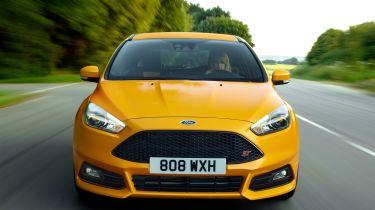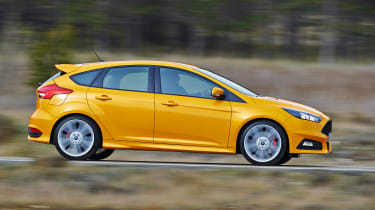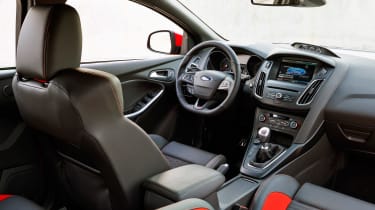Ford Focus ST diesel 2015 review
Ford's Focus ST hot hatch gets a diesel engine and a slightly more sensible, cost-conscious persona but it's still a blast!

The best way to think of the new Focus ST diesel is as a Focus ST ‘Lite’. It doesn’t accelerate as hard as the petrol model, but from the inside it sounds surprisingly like it, steers with similar levels of precision, looks just as mean and costs exactly the same. If you’re after usability and fuel economy over outright thrills then it beats the petrol hands down. Our advice would be to spend the extra £1,100 more on estate version making it the perfect fast, fun family transport.
Now that a full-fat Ford Focus RS – rumoured to have four-wheel drive and well over 350bhp – has been confirmed for production in 2016, the Focus ST has a more sensible, supporting role to fulfill. So, as well as fully updating the 247bhp 2.0 EcoBoost model, Ford has introduced a VW Golf GTD-rivalling diesel version for the first time. Ford has high hopes for this model in the UK - and with good reason - nearly a third of all Focus STs sold since the first-generation launched in 2002 have been to UK buyers. And this is a car sold in 40 countries around the world don’t forget. But can a diesel car really be called a hot-hatch?
Based on the existing 148bhp 2.0 TDCi, but with a retuned ECU, modified air intake system and a sports exhaust, the new engine produces 182bhp and 400Nm of torque. Peak power arrives at 3,500rpm, but as with all diesel engines that’s largely irrelevant, what matters is you can access maximum torque from 2,000rpm to 2,750rpm so 0-62mph takes a slightly lacklustre 8.1 seconds, but 31-62mph takes a sprightly 6.9 seconds.
By adding stop-start, economy and emissions for the petrol ST have been improved by six per cent to 41.5mpg and 159g/km, but that’s still some way behind the diesel. Figures of 67.3mpg and 110g/km mean the ST even starts to make sense as a company car – with higher rate tax payers forking out £132.84 a month, £42.84 less a month than the petrol model. Squeeze the throttle on the move and in-gear acceleration is predictably punchy. What’s remarkable, though, isn’t the straight line performance, but the linear, smooth power delivery so it’s predictable and manageable to drive fast. Ford has even engineered in a sound simulator that pumps in engine noise (eerily similar to the petrol ST) through the speakers. And it works, making the car sound throatier and feel much sportier than a standard 148bhp 2.0 TDCi.
Used - available now

2021 Lexus
UX 300e
22,738 milesAutomaticElectric
Cash £16,063
2023 Peugeot
3008
27,941 milesAutomaticDiesel1.5L
Cash £18,497
2022 BMW
X1
46,719 milesAutomaticDiesel2.0L
Cash £18,097
2020 Hyundai
Ioniq hybrid
45,952 milesAutomaticPetrol1.6L
Cash £12,497• Best hot hatchbacks to buy now You can only order the ST with a six-speed manual gearbox, but that’s absolutely fine by us, especially when the gear change is a snappy and precise as this. On the two lower trim levels – ST-1 and ST-2 – 18-inch alloys are standard, while our top-spec ST-3 test car was fitted with 19s. Even so, the ride never felt overly harsh. Small undulations in the road surface cause you to bob up and down in the sculpted Recaro seats, but harsher obstacles – like speed bumps and potholes – are nicely rounded off. We had a go in the petrol model too, just to refresh our memory, and the performance gap is fairly wide. Floor the throttle and the petrol model snaps forward, whereas the diesel surges, and when the petrol model snarls, the diesel warbles, but there are pros and cons to both. On the wet roads we drove around Barcelona the petrol model span its front wheels up at every opportunity, causing sudden understeer, while the diesel is less spiky. That said, the extra weight in the diesel nose also causes it to push wide if you arrive at a corner with too much speed.
Find the grip and there’s absolutely nothing wrong with the way the diesel tackles bends, though. Compared to the outgoing model, it gets all-new front springs and firmer dampers all round, while a quicker ratio has been dialed in to the variable steering system. There’s a meaty weight to the wheel that suits the car and it reacts instantly off-centre – perhaps too quickly to begin with, but you soon learn to use less lock. Add in tight body control and it actually feels a fraction more agile than the outgoing car. The performance from the diesel engine might be slightly tamer than the petrol, but you won’t be able to tell the difference from the outside. Both models get a more sculpted bonnet, slimmer headlights, wider grille and larger intake in the front bumper. Chunkier side skirts, a redesigned roof spoiler and diffuser elements either side of the twin hexagonal exhausts finish off the look. It’s a wilder design than the straight-laced Golf GTD, but this is a car than can trace its roots back to the Escort Cosworth, so what else would you expect? Fortunately the interior has grown up, with a new 8-inch touch screen Sync 2 infotainment system on top-spec models that looks great, and has a voice recognition system that actually works. The flat-bottomed steering wheel, trio of guagues, and flashes of colour add just the right amount of flair, too, while it’s piled high with new technology, including adaptive headlights and auto braking up to 31mph.









